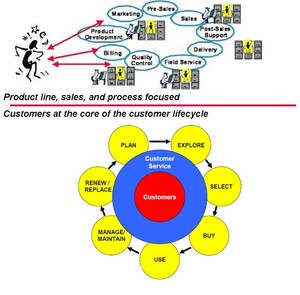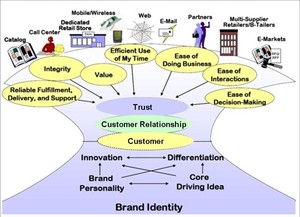Defining the Customer-Centric Organization
What Are the Attributes and Behaviors that Define True Customer-Centricity?
Is yours a truly customer-centric organization? We present the eight key attributes and behaviors that characterize an organization that holds customers at the core. How well does your business (or non-profit, or government organization) commit to customer success, engage with customers, provide top-down support, engender a customer-centric culture, recognize the customer across all lines of business, design processes from the customers’ point of view, measure what matters most to customers, and foster customer innovation?
NETTING IT OUT
As advocates of designing your business with customers, we recognize that all the Customer Co-Design initiatives you undertake won’t reach their full potential unless they are done within the context of a truly customer-centric organization. Here we explore the key behaviors that represent such a business (or non-profit, or government organization).
- Commitment to Customer Success
- Engaging with Customers from the Get Go
- Customer commitment from the Top Down
- Engendering a Customer-Centric Culture
- Recognizing the Customer across All Lines of Business
- Designing Processes and Policies from the Customer’s Point of View
- Measuring What Matters to Customers
- Encouraging Customer Innovation
Putting Customers at the Core
© 2013 Patricia Seybold Group Inc.
1. In a customer-centric organization, the customer is at the core of everything as they traverse the customer lifecycle. All processes and company activity are done in support of what the customer is trying to accomplish.
PLACING CUSTOMERS AT THE CORE
Today’s businesses all claim to be customer-centric. Indeed, since Patty Seybold and I published “Customers.com” in 1998, all organizations have come around to the concept that customers need to be at the core of every successful business…or non-profit…or government organization. However, even now, most companies don’t have all the component pieces in place to truly claim the “customer-centric” mantle.
So, how do you create a successful customer-centric business? You start with customers; not products. You focus on what those customers want to do. If you design any organization (for profit or not for profit) from the customers’ perspective, your organization will remain nimble and focused on customers’ changing needs and market conditions.
And, as customers, we recognize when we’re interacting with a company that really values us and our business. It’s clear that everyone in the organization understands what we need and what’s important to us. We also notice when we cross the boundary between the customer-centric brand we value and one of their partners who doesn’t deliver the same kind of experience.
As customer-centric executives, we want to anticipate customers’ needs and delight them with solutions they might not have thought of, yet they immediately love and value. We want our customers to bond with the enjoyable experience that we, and our entire customer ecosystem (organizations that are aligned around what the customers are trying to do), provide.
Thus, the customer-centric organization creates products, processes, policies, and a culture that are designed to support customers in their endeavors and to provide them with a great experience as they are working towards their goals.
Customer Needs Govern Your Organization’s Behavior
© 2002-2013 Patricia Seybold Group Inc.
2. At the core, of course, is the customer’s and his relationship with your organization. Customers will trust your company and stay loyal to your brand when you offer a consistent customer experience, through all your touchpoints, that meets the customer’s requirements for doing business with your organization and that helps him achieve his goals.
ATTRIBUTES AND BEHAVIORS OF A CUSTOMER-CENTRIC ORGANIZATION
After years of working with businesses striving to live up to a customer-centric philosophy, along with the same number of years working with and listening to customer reactions, needs, wishes, frustrations, and demands, we have come up with a list of attributes and behaviors that truly customer-centric organizations demonstrate (or are working towards). How well does your organization stack up?
- Commit to Customer Success
- Engage with Customers from the Get Go
- Customer commitment from the top down
- Engender a Customer-Centric Culture
- Recognize the Customer across all Lines of Business
- Design Processes and Policies from the Customer’s Point of View
- Measure What Matters to Customers
- Encourage Customer Innovation
Commit to Customer Success
Customer-centric organizations understand that, in order to be successful, their customers need to succeed. And there is a lot of emphasis placed on the “customer experience.” But customer success isn’t based on just having a good experience, although that is a very important piece. It is all about customers achieving their goals. Tony Ulwick called this “outcome-driven innovation,” and convinced Clay Christensen, the famed Harvard Business School professor, to devote a chapter to it in his 2002 book, “The Innovator's Solution: Creating and Sustaining Successful Growth,” you “don’t sell products and services to customers, but rather try to help people address their jobs to be done.” This is our approach also, what we call “customer scenarios,” which we’ve been practicing since the mid-1990s.
WHO ARE YOUR CUSTOMERS? Note that helping customers get their jobs done means understanding who, exactly, are the customers that you serve. It is important to realize that the person who gives you money might not be your end-customer—the one for whom you are providing products and services.
For example, if you have corporate customers, you might be paid by a purchasing department. But the purchasing agent, most likely, never actually uses what you offer. They are buying on behalf of others. (Note, however, that even in corporate accounts, each person who deals with you is an individual and deserves a great experience that satisfies him or her.)
Similarly, a college is often paid by the parents of the students. But it is the students who partake of the products and services.
And a non-profit shouldn’t think that donors to the charitable efforts are the primary customers. For example, the American Cancer Society is set up to provide services to cancer patients and their families. If it focused on donors, all services would be about fund raising rather than providing medical information, transportation to clinics, and comfort to those in need.
A truly customer-centric organization will work to understand what their end-customers are trying to do and help them get that done with ease, grace, and a positive experience...
(Download the PDF to read the entire article.)
Sign in to download the full article
0 comments
Be the first one to comment.





